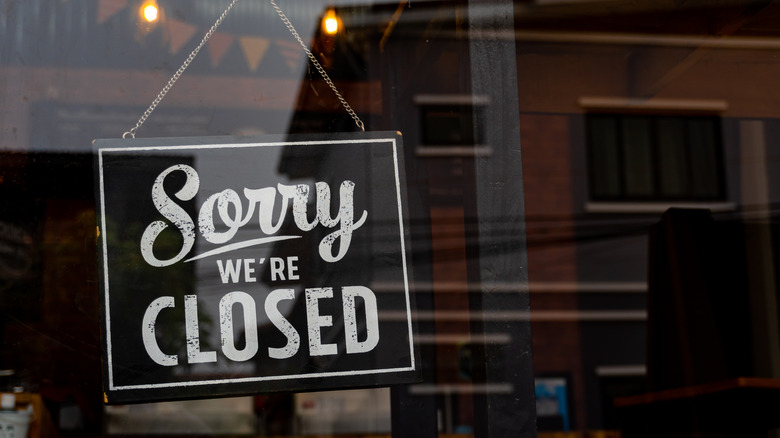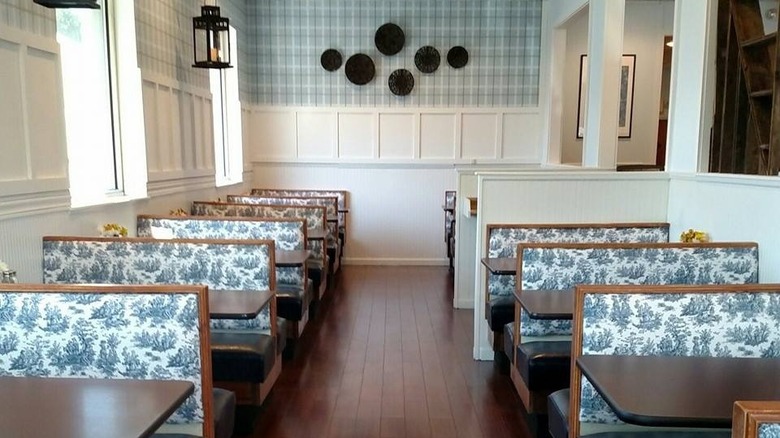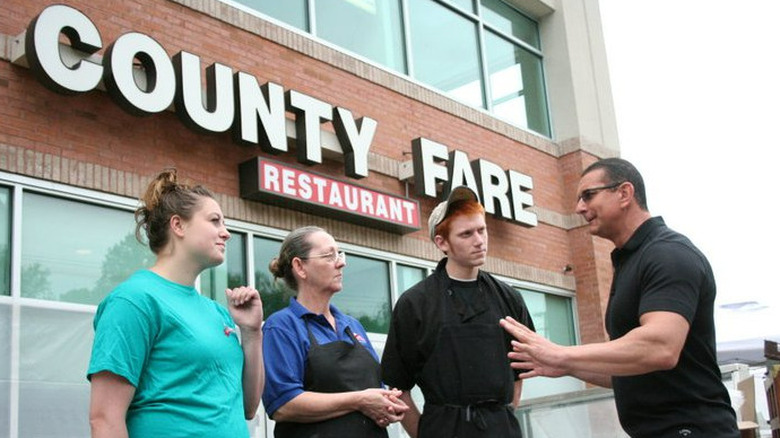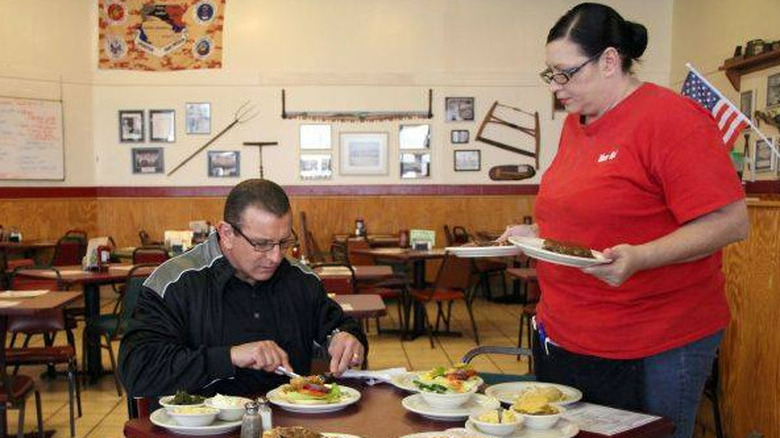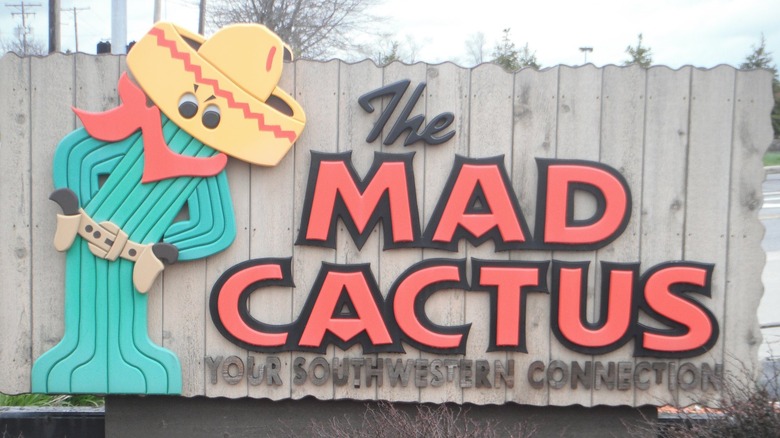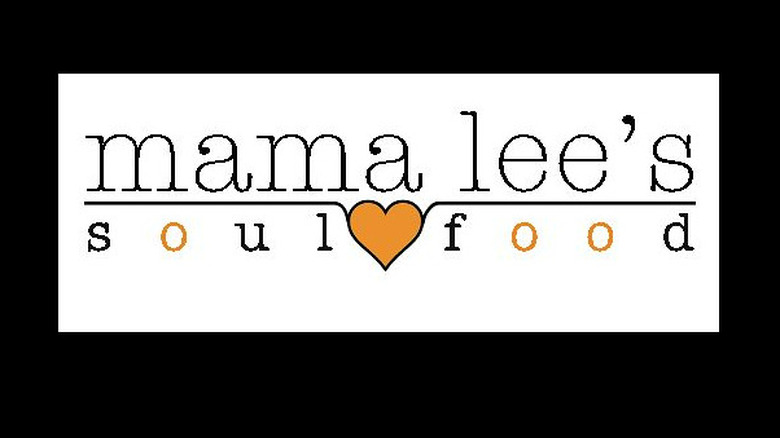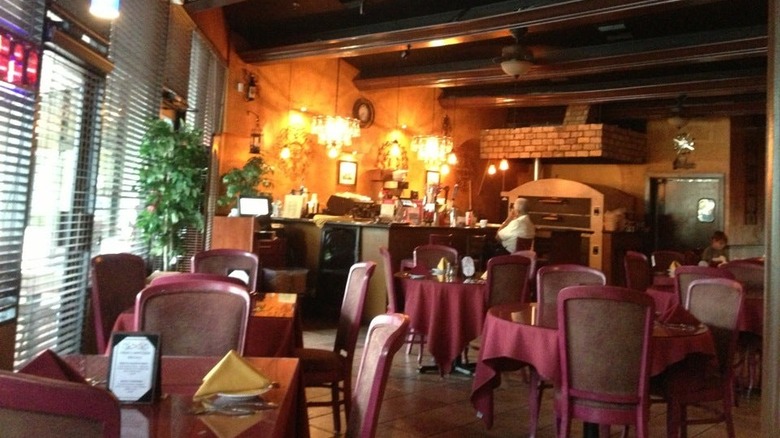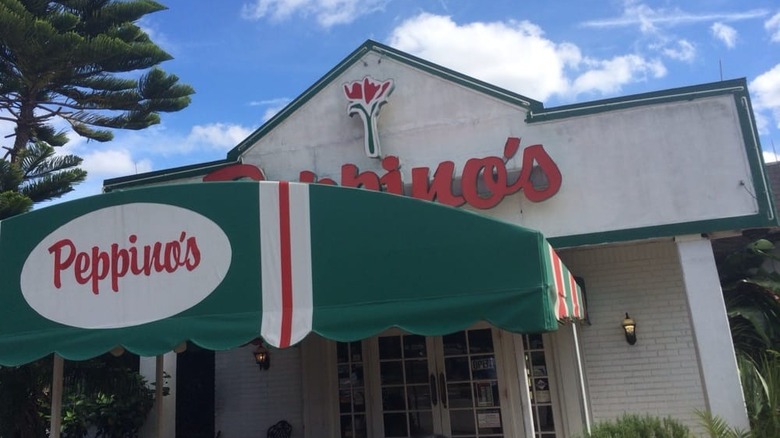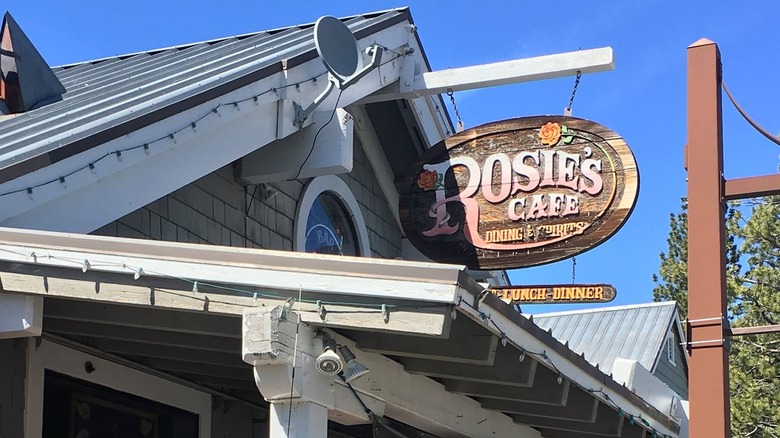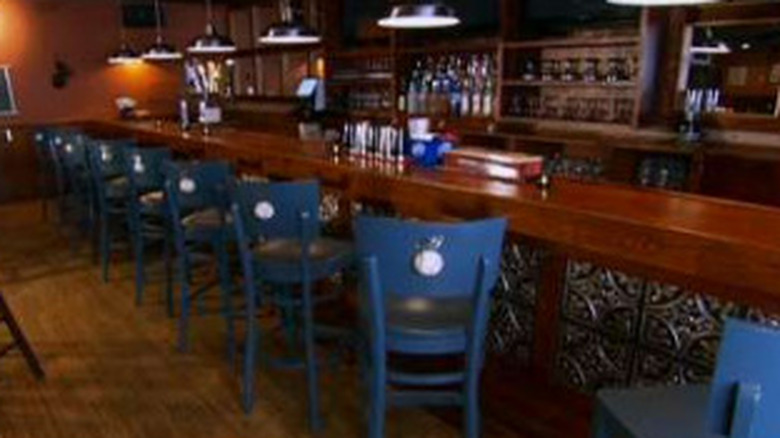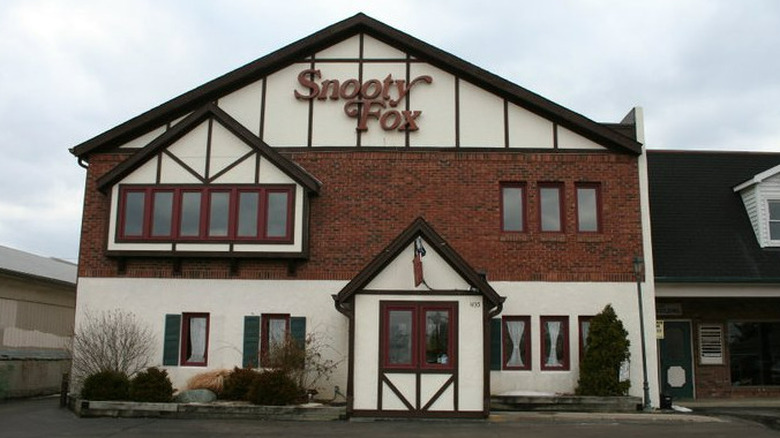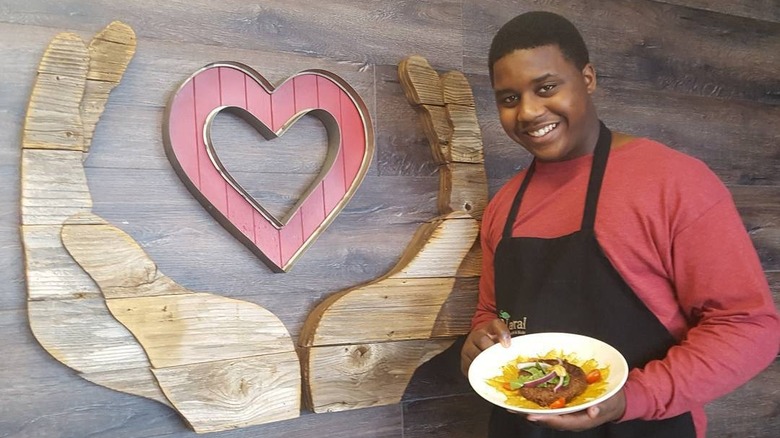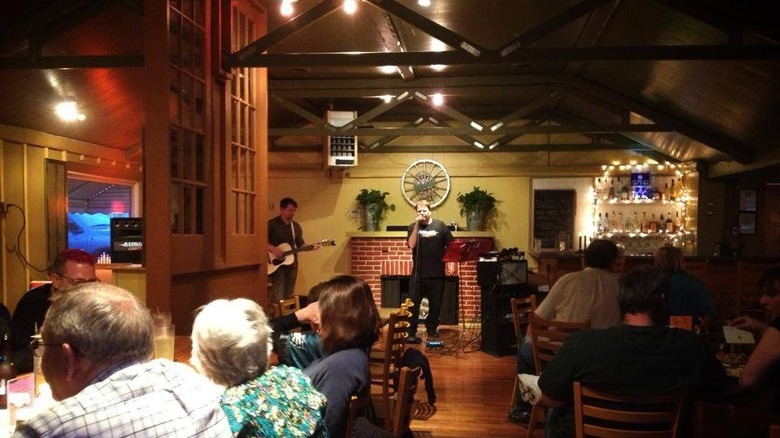This Is How Many Restaurant: Impossible Restaurants Shut Down
"Restaurant: Impossible" has helped transform many restaurants over the years. The team, which has Robert Irvine at the helm, has taken on immense challenges, including restaurants coated in grease and grime, restaurants with outdated decor, and businesses staffed by hotheads with bad tempers. Throughout the show's numerous seasons, the "Restaurant: Impossible" mission has impacted many families, owners, and entrepreneurs. The show has covered over 205 restaurants in its episodes. Of those, many went on to thrive and succeed, thanks to the help from the "Restaurant: Impossible" team. Some took the helpful advice and turned their business into bigger successes than ever, but others were not so lucky or motivated.
As it turns out, sustaining a restaurant isn't easy, even with a professional team's help. As of March 2023, 124 of the 205 total restaurants have closed their doors since filming, leaving the transformative show with a 40 percent success rate. Whether the owners closed the businesses of their own accord or due to uncontrollable factors, Irvine and his team gave each one their best effort and left the owners with the choice to adapt to his suggestions for success or face a tough decision. Unfortunately, some of the fan-favorite restaurants took a turn for the worse and closed their doors for good.
The Anchor
In season 19, episode 1, viewers met Lane, the owner of The Anchor, in Louisville, Tennessee. Lane's family turmoil took a front-row seat during the episode as Irvine, and the team tried to help rebuild Lane's broken familial relationships and helped him brush up on his business practices. The episode ended with a hopeful tune and left Lane and his daughter reunited while giving his son a much-needed boost in confidence and responsibility. It seemed that things would turn around for the waterside restaurant, but apparently not.
After filming, The Anchor received several mixed reviews regarding the food quality, service, and even the bathrooms. According to sources, Lane's daughter got a different job shortly after the show aired, which was significant, considering the fact that her returning to work at The Anchor was a huge focal point of the show. Users in a Reddit forum speculated that the continued family drama was to blame, with one source claiming that Rob (the son) ran the place into the ground after a scandal with his fiancée that involved an order of protection. The drama seemed to continue at The Anchor, ultimately leading to its demise by the end of 2021.
Cape Horn Family Restaurant
Cape Horn Family Restaurant in Red Lion, Pennsylvania, was another family business that met its match in terms of restaurant ownership. The show was filmed throughout October and aired on December 3, 2015, in season 12, episode 6. Irvine and the show's team swept in to help owner Joni get things into shape. Some of the changes addressed the lazy servers, the attitudes of the staff, poor food quality, and the financial stress of the owner and her husband.
The episode ended with a happy Joni, improved staff morale, and an exciting new plan for a different menu. After filming, the implemented changes brought on new customers, a near loss of existing customers, and a few old menu items returned to the rotation to keep the regulars coming back. Unfortunately, the progress was all for naught, as Joni was diagnosed with cancer in January. Cape Horn Restaurant closed down as she battled toward recovery through July 2016. While the plan was for the restaurant to reopen eventually, that sadly never came to fruition, as Joni passed away in June 2017.
County Fare
In season 2, episode 3 of "Restaurant: Impossible," Irvine and his comrades pulled up to a diner in Stafford, Virginia. The owner was facing bankruptcy, some dirt and grime, and a lot of stress, and he desperately needed help. Irvine was more motivated than usual to help this owner, Eric Green, who also came from a military background, which Irvine related to and respected. After some significant changes by the end of the episode, the County Fare crew was in good hands, with an exciting and fresh start before them.
Unfortunately, the Stafford County restaurant did not hang on for as long as fans hoped. Stafford County Sun staff wrote a melancholy farewell to County Fare, which was set to close shortly after filming. Supposedly, Green reported improvements in their business the first month after filming before a drop in sales that was worse than the restaurant had seen in years. Reviews on Yelp tended to range between average to poor and reflected that the restaurant was often closed when it was supposed to be open. County Fare closed its doors for good six months after the show aired in October 2011.
The Dinner Bell
The Dinner Bell's owner Tommy stands out in viewers' memory as one of the only chefs that was brave enough (or dumb enough) to buck up to Irvine on camera. While he and Irvine intensely clashed throughout filming, the Restaurant: Impossible team ultimately made a positive impact during their visit to Madison, Tennessee. This episode was one of the most difficult to film due to its raging tempers and tantrums, but it ended on a positive note, with hope for The Dinner Bell's future.
The episode aired in February 2013, and the restaurant reportedly had already returned to its old ways. Tommy reduced the prices back to their original state (at which he was not making a profit) and ultimately closed in April 2013, thanks to the economic impact on pricing for food and supplies. Additionally, The Dinner Bell received mixed reviews after the transformation, which reflected that much had stayed the same.
The Mad Cactus
The Mad Cactus and its issues with food, service, and everything in between led the "Restaurant: Impossible" crew to Strongsville, Ohio. Irvine and the owner Tom worked together to make meaningful changes in the restaurant's finances and to instill a proper management hierarchy. Though Tom put up some mild resistance, he conceded where it was necessary, and viewers ended the episode with a fresh look and new plan for The Mad Cactus.
After the episode aired, there was a bit of animosity from Tom regarding how Irvine treated him during filming. He claimed that Irvine was constantly losing his temper, and the show was set up to depict The Mad Cactus in a negative light. Despite the drama, business for The Mad Cactus increased by about 20 percent after the show's intervention, and the restaurant seemed to get good reviews.
That all changed when Tom decided to bring back the old menus and return to many old habits. This led Yelp and Trip Advisor reviewers to share their dissatisfaction with their restaurant experience and its practices. Ultimately, the poor choices and reverting led to The Mad Cactus' closure in July 2013, just two years after filming. A local paper picked up the story and reported the bittersweet ending to the restaurant that had previously been a local symbol for 28 years.
Mama Lee's
Cockroaches, outdated decor, and a tired owner led Mama Lee's to the spotlight of Restaurant: Impossible, season 3, episode 8. This restaurant needed extra support, which led Irvine to call in reinforcements in the form of HGTV's "Kitchen Cousins," Anthony and John. The owner of Mama Lee's, Ken, was out of sorts and needed assistance. By the end of the episode, Irvine and his team instilled new confidence into Ken, a feeling of ownership among staff, and a newly decorated, neat, and clean space.
From the significant improvements viewers were left with, one could assume that Mama Lee's went on to lead a happy, long life of serving food. Sadly, that was not the case. A local, San Antonio-based publication picked up the closure story and reported that the final straw came very near a failed health inspection from June 11th. The inspection revealed a continuation of the original cockroach problem, some issues with food handling and storage, and reported that a few additional pests had also moved in. Yuck. With 42 inspection demerits on the scale that typically caps off at 30, Mama Lee's finally closed its doors in July of 2013.
Mainelli's
Irvine took off to Providence, Rhode Island, to visit Mainelli's, a family-owned Italian restaurant. Jerry Picaro pleaded for help after the business began losing more than it was making each month. Mainelli's also had issues with the gas company shutting off its supply and the community not knowing if the restaurant were open or closed. After a temporary closure in the past year, Mainelli's closed for good. The episode ended with new signage, a corrected community perception, better food, and nothing but potential.
After the show aired, reviews for Mainelli's were positive, indicating a change had taken place. Unfortunately, through no fault of Jerry or his staff, Mainelli's fell into horrible luck when a car crashed into the side of the building. This naturally required another closure to repair the damage, leaving the owners with a plan to reopen later. The reopening never happened, and the Mainelli's building went up for sale at an auction in September of 2013, just two years after filming.
Meglio's
Meglio's, yet another Italian restaurant, drew Irvine and the "Restaurant: Impossible" team over for assistance. Meglio's was based in Bridgeton, Missouri, and it was owned by John Meglio, who came from a long line of restaurateurs and entrepreneurs. His attempt to live up to a legacy had run him into debt, despair, and near destruction. Thankfully, Irvine helped bring in fresh decor, fresher food, and some marketing tactics.
In a bit of a rebellious act, Meglio brought back a dish Irvine took off the menu and did the same with a few others. He claimed that the locals wanted the old food back, although the previously interviewed locals did not seem to echo that sentiment. David Segal of The New York Times reported that Meglio had an excuse for the backward changes. He claimed that the diners in his community had eaten frozen pasta for 50 years: It's part of Midwestern culture, and too much change may freak people out. Apparently, his logic didn't hold true because Meglio's closed its doors permanently in 2015, which led to the location going up for lease.
Peppino's Ristorante Italiano
Louis and Susan Lonetti owned "Peppinos's Ristorante" in Oviedo, Florida, and sought the help of the "Restaurant: Impossible" team. The couple had owned the restaurant since 1992 and had invested a lifetime of work in the business. Irvine had his hands full with debt from last year's financial outcome, a family/staff member with a drug issue, and a design that needed updating. Irvine remade the menu, got the staff into shape, and launched a new look with an exciting promise of improvement.
The episode aired in March of 2016, and Peppino's closed its doors in January 2020 due to reports of business slowing down to the point that the Lonettis had no other option. A local newspaper picked up the story and shared interviews that echoed the same. Locals shared that they never saw many cars in the parking lot and didn't get the impression that it was a particularly successful restaurant. They also highlighted the plans to turn the building into a clinic.
Rosie's Cafe
Kaitlyn Pilsbury was perhaps destined to be a chef if her last name was any indication. She owned Rosie's Cafe, which was the focus of season 14, episode 1. Rosie's Cafe was nestled in Escondido, California. The restaurant gave off a bad first impression to Irvine due to its unsightly decor and disorganized management. In typical fashion, Irvine and his team came to the rescue and boosted Rosie's Cafe to a better standing before the episode concluded. Filming wrapped up around January 2019, leading to a year of improved success for the eatery and its owner.
In December 2019, Pilsbury was the hit-and-run victim of a motorcycle accident. Her injuries made it impossible for her to work, and they also cost a pretty penny. Irvine was notified of this unfortunate circumstance and coordinated a fundraiser to help, which it did, to the tune of $118,000. Unfortunately, even that wasn't enough to keep Rosie's Cafe in business after the pandemic struck. The unfortunate and one-of-a-kind circumstances of the pandemic led to a forced closure that later became permanent. We can only hope that Pilsbury gets another chance to shake off some of her bad luck in the future.
Scrimmages
It's probably not a good idea to combine mortgage debt with your buddies to secure a restaurant deal, yet that's exactly what Brian, Jerry, Mike, and Leon did when they purchased the restaurant Scrimmages in Wilmington, Delaware. The friends/owners were facing financial stress, a smidge of resentment, and a constant loss of finances: They were not in good standing when Irvine met them. Additionally, the customers reported slow service and cold food. The episode ended with a successful relaunch after the implementation of changes.
After the show aired in 2011, Yelp reviews still didn't favor the restaurant or its staff. Since the restaurant had poor ratings, it wasn't a massive surprise that it eventually shut down. By the time it closed its doors in November of 2013, the Yelp review yielded a mere two and a half stars. Even reviews on TripAdvisor were grim, with reports of poor service and many of the same issues that were present before the show's intervention. Unfortunately, it seems the fate of Scrimmages is sealed.
Snooty Fox
Snooty Fox restaurant, owned by Tim and Cathy Queisser, was located in Indianapolis, Indiana. The restaurant had 29 years of business under its belt, so one would think that things ran like clockwork, but as is the case with all "Restaurant: Impossible" stops, that was not the case. Irvine helped tackle the issue of limited clientele and various forms of debt, not to mention the fact that the restaurant's head chef had walked out: Fun.
He also worked on boosting business so the business could get back on track. Irvine also helped resolve kitchen hazards and assigns people to new roles that may have better suited the restaurant's needs. The evening relaunch brought a gaggle of customers and happy owners that turned the business around for about three months. Apparently, after a short boost in sales, online comments revealed persistent issues with service and the food. Unfortunately, the naysayers were the first wave that led to Snooty Fox's closure in October 2011. Since then, a new restaurant has taken hold of the location and seems to be thriving.
So Natural Organic Restaurant
So Natural Organic Restaurant in Harker Heights, Texas, was a bustling family business. However, when Irvine and his team visited in 2016, the family was practically crumbling under the weight of an unstable business. Irvine's visit in April 2016 was a total surprise to the family, and it led to a flurry of change and excitement among the owners. The family had a passion for healthy food, and they hoped Irvine's visit would help spread the word about the restaurant's existence.
Irvine's help led to a prosperous business increase after filming, and the family stood by the renovation as one of the most helpful factors and the show itself as a massive source of business. Apparently, visitors from across the country stopped by purely because they had seen the show. The success continued for about two years, with the family later deciding to close the restaurant and focus their efforts on location and catering. Now, the So Natural Organic Restaurant has been replaced with So Natural Catering.
Wagon Wheel
This "Restaurant: Impossible" restaurant featured a surprising dish on its menu: The Wagon Wheel in Delaware offered muskrat, and that was only one of the iffy choices available at the restaurant. Irvine rolled in to help and was not a fan of the marsh rabbit that hit his plate or the dusty floral decor. Owner Patty Gallegos ran the business and carried on a line of three family generations who did the same. Her daughter Sheila also worked in the restaurant, as did other family members.
Irvine helped the restaurant regain its standing, although he couldn't convince Gallegos to remove the muskrat dish. All things considered, he left the Wagon Wheel in much better condition than he found it. The community resisted the restaurant's new changes, which may have hindered its success. However, it is more likely that the departure Patty's daughter ultimately made the business quite unstable. Wagon Wheel went down in "Restaurant: Impossible" history as the third Delaware-based restaurant Irvine had taken on at the time, and it added to the statistics of closures. Patty decided to prioritize her health after spending 40 years of her life on the family-based business, and the Wagon Wheel restaurant closed its doors in September 2014.
